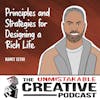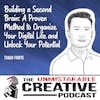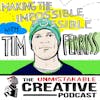Bent Flyvbjerg | How Big Things Get Done: The Key to Wildly Ambitious Projects

Bent Flyvbjerg shares his insights on the key principles that distinguish successful big projects from the failed ones.
Subscribe for ad-free interviews and bonus episodes https://plus.acast.com/s/the-unmistakable-creative-podcast.
Hosted on Acast. See acast.com/privacy for more information.
Srini: Bent welcome to the Unmistakable Creative. Thanks so much for taking the time to join us.
Bent Flyvbjerg: Thank you very much. Thank you for having me.
Srini: Yeah, you have a new book out called How Big Things Get Done, which is all about making huge mega projects happen, which I absolutely loved. But before we get into all of that, I want you to start by asking you what did your parents do for work and how did that end up shaping the choices that you've made with your life and career?
Bent Flyvbjerg: My father actually construction site manager. So I grew up on construction sites and I think that has a lot to do with my professional interest and my academic interests. And my mother was a social worker,
Srini: And how did that shape what choices you made and what did you learn from them, from their experiences the work that you ended up?
Bent Flyvbjerg: I think the first thing that I learned is that I really like construction. So my parents would take me along to the places where my father worked, and that could be buildings or bridges and tunnels and so on. and I don't remember not going to construction sites ever.
So this must have been from, I was a baby. And I remember the smell of construction sites. I remember, the the people who worked there that I, they look like big, strong people and doing very interesting things. There'd be there'd be noise, there'd be smoke and stuff, and dust and like something that appeals to a kid, later on when I became a teenager I actually got to work on construction sites. So my father got me jobs on construction sites and. Just means that I've been in, interested in how to build things and how to build big things from a very early age.
Srini: . And then what about from your mother in terms of the social work side what did she teach you about people, human relationships and making your way in the.
Bent Flyvbjerg: Yes. So my mother, would would teach me exactly about that, that. It's it is not only about things, it's also about people. And I actually think that's a really important insight. It actually turns out now when I study these things as a scholar and we dig really deep, it's more about people than it's about things.
It's always the people. And that's actually something that comes out in our book. Right up front we make it clear they're two root courses of why things go bad or well, and those two root courses are psychology and power, and So we are not talking about anything that's got to do with buildings or artifacts or bridges or anything, or it systems.
This is actually about people, right? Psychology is all people. Power is all people.
Srini: totally. We'll get into that. One thing I wonder, I you're an educator. I assume you were educated in den. , and this is something I always wonder with educators. Two things. One, I don't know how much time you've spent looking at the American educational system, but I'm curious about what the differences are in the way that you were, educated versus probably somebody like I was educated.
And if you were given the task of redesigning the global education system from the ground up, speaking of a mega project, what would you change about it right now?
Bent Flyvbjerg: First of all, I was actually also educated in the American educational system, so I was educated in Denmark and the United States, specifically us, ucla, university of California, Los Angeles,
Srini: Okay, so we have background then, cuz I was a Berkeley undergrad,
Bent Flyvbjerg: alright. Yeah, and I spent a lot of time at Berkeley too. I had mentors at Berkeley and. , so I know both systems well, both the Danish Scandinavian system and the American system and yeah, they're very different.
So the main difference is that you get, actually, you get paid to go to university in Denmark. People just fall off their chairs, when I mentioned that. So my daughter recently graduated from university. And at this stage, she was paid about, eight, $900 a month to attend university, so to cover her living expenses.
And that's on top of getting to live in heavily subsidized student housing. With your own bathroom your own bedroom shared, had kitchen and so on. So that's the main difference is that education is considered a public good that people should get for free. And not only for free, you actually pay young people to go to school because you want to incentivize them to get educated.
And that's how you have this very high level of education in Scandinavia because the kids are actually paid to go to school and everybody's encouraging to do that and saying that's the future. You need to be educated in the kind of society and the kind of world that we live in today.
So education, health, housing, and so on are considered social goods not private goods. Like in the states where you have to fight for it yourself, you have to pay for it yourself. It is actually a real problem if you have. , if you have many kids, how can you even afford to put them through school?
That's the main difference. And if you ask me how as a mega project would I design education, I have no doubt I would do it the way it's done in Scandinavia and the Netherlands. By the way, I consider the Netherlands, an honorary part of Scandinavia because the country, I've also worked in the Netherlands at.
Technical university in Delft, which is also a very good university. And they do it the same way in the Netherlands as in Scandinavia. And that's the way to go. That's the way to make societies rich, to have a lot of educated people and make sure that they have good jobs.
Srini: . So what I wonder then, as somebody who has an economics background, let's talk about incentives, right? Because, every Indian kid has the story of going home and telling their parents. Some kid at school gets paid for good grades, and your parents look at you and say, you're outta your damn mind.
You get a roof on, over your head and a meal on table. Get back to work. But it makes me think about the sort of intrinsic and extrinsic motivation issues when you're paying people to go to school. Because, I wonder how that, like aligns with incentives when you're paying people to go to school.
I From the perspective of somebody with your background, how do you resolve that?
Bent Flyvbjerg: The incentives are not so strong that people will actually choose to go to school just because of the money. You'll actually make more money if you get a regular job than by being a student. I think the level of incentives are set just right. But you need to live, if you go to school, , you actually want the kids to study instead of running around being, working at a McDonald's or something like that.
That's not a good use of your time. If you are in this really high level institution that a good university is, you want the kids to spend their time in the university, not flipping burgers at a hot, at a burger stand, .
Srini: Yeah. so to me one, what the curriculum is and obviously this is a huge issue here in the United States, the fact that we've riddled a, practically an entire generation with student loan debt. And what I wonder about is how you could actually bring some of that to the United States.
Because I think there's one argument that people always come back to, and that is that, oh Scandinavian countries are small, therefore it's possible there, but it's not possible here, which I don't entirely agree with because we're not accounting for every variable. But I also don't know because I'm not, a person who makes educational policy.
I'm just somebody who's interested in this as somebody who has student loan debt.
Bent Flyvbjerg: Student loans are common in Scandinavia, subsidies are not enough to live by. And so you need more. And and many students take loans. It's not necessary. You can go through university without loans. My daughter didn't want to take loans, so she didn't do it. She worked on the side instead.
I took loans when I was a student. I thought that my time was better spent on studying than going out and working at, a low paid job. So I took loan and loans and it took me about 10 years to pay them off after I'd graduated. It wasn't a huge amount. It's not like what you hear the horror stories from the United States, but it's there.
It's there and it's, it means something. So I think loans to a degree can be okay. , your other observation and question. Whether this is only something for small countries. I don't see why, why would it be something only for small countries? I actually don't see what size of country has to do with it.
You could always subdivide a big country into smaller units if that's your problem and then say, okay, we'll manage this within smaller geographical and administrative units and do it like that.
Srini: Yeah. So why do you think it hasn't happened in the United States? What do you think the barriers to this is? In the United States?
Bent Flyvbjerg: I think it's culture and one of the strongest thing we see when we study things around the world is that this thing about, this is the way we do things around here. And that's reason enough to do it around there because this is the way we did it in the past. That's why we do it now, and that's why we'll do it in the.
Srini: . Yeah.
Bent Flyvbjerg: So it is culture. It's culture and habits, and it's very hard to change culture. You know how they say in, in corporations that culture eats strategy for breakfast. So you can have all the strategy that you want to change something like this. If the culture is that we don't do it like this, we don't do it like that, and the strategy will not get implemented.
Srini: Yeah. How is the curriculum different in Denmark versus the United States? Because, I you went to ucla, I went to Berkeley. You and I both know this. You sit in these large lecture halls where you're literally just a number and when you take an exam, you don't even have a name. They just give you a student ID number,
Bent Flyvbjerg: Yeah. Yeah. There's a bit of that in Scandinavian universities. It varies a bit. There's a new pedagogical model that is being increasingly implemented that is called problem-based learning. PBL is called for sure, problem-based learning. And the universities that subscribe to that model typically use much smaller groups of students.
And actually the students work in at the most micro level . They work in groups of, five to seven students in each group. And they get projects that they have to solve each term or each semester, whatever the unit is. And and then they have some classes, to support that.
So 50% of the work is spent on their project, which they do in this group of five, seven people. And 50% of their time is spent in classes, but that are typically much smaller than the several hundred students you might see in traditional big lecture. . And it turns out actually that the students that are going through that model and the universities that are using that model are performing better than the traditional model, which is the large lecture halls.
So there's a movement away from huge lecture halls towards smaller groups of students because it appears to be better pedagogy to do it.
Srini: . Yeah. Speaking of problem-based learning, what has been the trajectory of your career that led you to writing this book?
Bent Flyvbjerg: I'm an economic geographer by training, so both my bachelor's, my masters, and my PhD are all in economic geography. What lack of imagin. , but that's actually part of the data system that this is common. You don't make the same changes as you do in the American system, where you can shift completely, from philosophy to economics and then to law, whatever.
So I did it all in economic geography, and that means that I got trained in urban ge urban geography and urban economics. So I've been trained at looking at cities, understanding cities, and designing cities as a matter of fact, to make them work better. At one stage, not long after I graduated with my PhD. I observed that cities got built in bigger and bigger chunks, so everything was getting PR projected as its court now. So before you talked a lot about plans and you had land use planning, and you needed to have a good land use plan for a city, and then you developed the city according to that. That whole conversation changed a while ago into talking more about projects, specific projects.
So we need a. Urban Rail project here. We need a new energy system or we need a new housing project over here, whatever. And so things became more about project and big projects and I noticed this change and I, at that stage, I, in my interpretation, that's the future. No, that's what I thought at that stage.
This is the. and it's turned out to be true. That it, it was, and it is the future. So things have been, become more and more project by the projects have become more in number and numbers, and the projects have become much larger in, in millions, and then hundreds of millions and then billions of of dollars.
And now, trillions of dollars. There are now projects that are measured in trillions of dollar dollars, unbelievably as that sounds. So that's how I got into this, was just looking at what's moving on the ground and seeing what's moving our projects. And they are actually what defined now our cities now.
I thought, 30 years ago. And then, I started looking around. Has anybody done research on this? Like how are these projects performing? This was actually my first question. wanted to know what's the performance of these projects? Are they doing well? Are they doing not so well? Do they get delivered on budget?
Do they deliver the promise benefits? Do they keep to their schedule? Questions like that, basic performance.
And at that time I went to the library. They, we still went to libraries at that time to find out what the situation was, talk to research librarians and so on, research the whole globe, for information about this.
And there was none. There weren't any big studies where you could statistically validly answer the question of how these projects are performing. And this is despite already trillions of dollars. Were spent on projects like this on a global scale, so rail projects were built housing projects were built, energy projects.
Eventually IT systems came in. Mining projects, defense projects, you name it skyscrapers, everything. And and you actually couldn't find
,
good data on this. So this is what a scholar loves. If there's a white area on the map where nobody has yet answered the basic questions that's what you want to go for.
So that's what I decided I wanted to go for, and I wanted to do the first study that actually answered the question, how are big projects? So that's how I started and it was very much inspired by my supervisor at ucla professor Martin, we, who was studying big transportation systems in in la including the LA Metro and other big projects.
And he inspired me very much to, to study this.
Srini: Yeah as a resident of Southern California, I can tell you that public transportation in LA is shit. terrible It's probably the worst
country. You opened the book by saying over budget over time, over and over again. The pattern was so clear that I started calling it the Iron Law of Megaprojects, and the Iron Law is not a law like a Newtonian physics, meaning something that invariably produces the same outcome.
And it got me thinking about a building in India that was across the street from my grandmother's house, and I remember looking at that building when I was there in seventh grade. And it was under construction. Then I went back two years later in ninth grade and it was still under construction.
Then I went back after my first year of business school, it was still under construction. And then in 2018, keep in mind, this was, I think 91 was the first time I saw this building in 2018. When I went back, I looked across the street and I was like thinking, holy shit, somebody finished this building. I remember asking, a girl that one of my roommates was dating about the difference between, main China and India, and she said you guys are a democracy.
That's why shit like that happens. She said, in China, if somebody wants to build a mega highway, it'll be done in three months. So talk to me about, why this happens. I, I in the first place, because I remember hearing a story and I'm paraphrasing this don't quote me verbatim on this, but it was about Apple's relationship with China and it was on the New York Times Daily podcast.
And, the Apple team went over there and they said we need to build a factory. And there was a giant mountain of some sort and the Chinese looked at them and said, don't worry, it'll be gone in a few weeks. And when they got back a couple months later, they had B gotten rid of a mountain and built a factory
Bent Flyvbjerg: right? Yeah. So that is a difference between China and we've actually started that. So we've done a regular scholarly study of how things are going in China, and it is a significant result that China is delivering projects much faster than we are in the West, not as People all also thought on budget.
They actually don't deliver on budget, even though everybody thought so until we did our studies. They go over budget like we do, but they do deliver. So the iron law still applies in China. They just get to it faster, in the sense that they deliver their projects faster. And the iron law is as, like you said, it's a statistical law, but it actually applies with a very high likelihood and a very high level of statistical significance.
Srini: Oh, hey, bent. I lost you there. Go ahead. Hold on. Just go ahead and press refresh on your browser window. And then we'll pick it up here. I'll have my editor pick this up. Edit it out here, and then I'll tell you where to pick it up. Yeah. . Yeah, just reload the brow. Just, yeah, just reload the browser window.
Just press reload. Yeah, just refresh the brow. There you go.
Okay, perfect. Just yeah if you can turn off your camera and then pick it up where you said, most projects are likely to go over budget. Like I said, I'll have my editor edit this out, so don't worry about that.
Bent Flyvbjerg: Why can't I see where to turn off my camera now? There we go.
Srini: There should be a little
Bent Flyvbjerg: Yep Got it Okay
Srini: All right. So go ahead and then just pick it up from, these projects going over budget.
Bent Flyvbjerg: Yeah. So did you get the thing about China?
Srini: Yeah, I did. And then just talk about why most big projects, end up going over budget, and all that stuff.
Bent Flyvbjerg: All right. Did you get the thing about the iron law? So I was in the process of explaining the iron law. Okay. S and yeah. Over budgets, over time, under benefits, over and over again, that's the iron law. And of course, the question is, why is this the case? And it's actually very strong, the case with very high likelihood, with very high statistical significance.
So it's really written in stone, that law even though it is probabilistic and not deterministic, your likelihood is very high. The thing will go wrong for you. It's like going to the casino and having a prediction. You are going to lose, those are your odds really that's what it's like.
Those are, that's. Behavioral economi is called base rates, and we have uncovered the base rates for building big projects and the base rates don't look good. So the base rates are like the odds if you go and play the roulettes or go and play blackjack in the casino. And one of the big mistakes that are made in projects is not getting the base rates, so when you ask why does this happen, that's. One fundamental answer is that people don't get the base rates right. They don't know what the likelihood is that they're going to be able to achieve what they say they're going to achieve at the course. They say they're going to do it at and at the schedule they say they're going to do it at.
They don't understand that the numbers that they come up with are to a last degree fiction. Instead of reality because they haven't gone back and looked at the empirical base rates for what it is that they're doing. They think it up from the inside out. As behavioral economists say they try to understand their project from the inside out instead of understanding it from the outside in understanding what the empirical reality is out there in the world when you're trying to do something like that.
. That's one thing, and this has already gotten us deep into behavioral economics. It's called the base rate fallacy in behavioral economics, that you actually mistake your base rates for what you're doing. And it's very common. Even if we are driving a trip across town, we have a certain idea of how long it's going to take, and very often it's wrong.
That's our base rate. We say it's going to take 20 minutes, but it actually takes 40 minutes. We got it. , we thought the base rate was 20 minutes, but in it was actually 40 minutes. So even at that mundane level, this applies and if you start observing yourself, you will see it over and over in your daily life.
Other things from behavioral economic that explains why things go wrong is optimism. And in a way you can say the base rate fallacy is a specific instance of optimism. So Daniel Canman the preeminence. Behavioral psychologist who got the Noble Prize in in economics in 2002 for his work all these cognitive biases.
He says that probably the most preeminent behavioral bias that we are subject to is optimism bias. So it appears that we are hardwired from nature to be. Which is probably a good thing, it's it probably has its function in evolutionary terms, and that's probably why we have it.
It makes us survive in certain situation. in other situations, as Canman points out, it can be a real disaster to be optimistic. So I usually like to use the metaphor with my students so they, remember what I'm saying? If you're getting on a plane and you. The co-pilot say to the pilot, I'm optimistic about the fuel situation. You wanna get off that plane, right? And you want the flight attendant to be an optimist, not the pilot. So I'm happy to have a flight attendant that say, we're going to give you the. experience you've had on a plane lately, and just leave it in our hands and you'll have a great flight.
That's the kind of optimism I like on the plane. I don't want to hear the pilot say, I'm optimistic about the fuel situation. It's the same on projects the fuel for projects is money. And if you're optimistic about the budget, that's a recipe for disaster. That's a recipe for a crash of the project.
Just as optimism about the fuel situation on the plane is a recipe for. A crash of the plane, right? So that's an example of optimism being misplaced. So that's misplaced optimism, and that's a huge problem. If I had to single out only one thing, just if I could only mention one thing of why projects go wrong, it's optimism. But if there's not only one thing, there are lots of other cognitive biases and that's only psych, the psychology side of thing. Then there's the power side of thing. And that's a new thing in this book. You don't hear about that a lot when you talk about projects about power bias. You hear a lot about cognitive bias, and that's behavioral economics for you and behavioral science, but there's actually a type of bias that I have found when I study these projects. completely or almost completely ignored by behavioral economists, and that's power bias. That is actually not only about psychology, there are also power issues. So psychology is innocent in the sense that people are not deliberate about being optimism. It's not optimism if you are de deliberately optimistic, then it's calculated So optimism is unconscious. buyers is conscious that actually is trying to game a situation. So if you are jockeying for position, that's a power situation. So you're working in an organization, it might be a big private corporation, or it might be government. You know that a lot of projects are being done and all these projects are in competition for a limited amount of.
you wanna make your project look as good on paper as possible In order to get those funds that are available, you want to be on top of the stack of the projects that get prioritized and get funded. How do you do that? You make your project look good on paper. You underestimate the cost so it looks cheaper than it will be.
You underestimate the schedule, so it looks like you can do it faster than it actually can be, and you overestimate the benefits or the revenues, whatever the unit is. . So it looks that you will achieve more with this project than you actually will. Then you are in business. You have positioned your project, in a way where it's it's jocking for the funding that is there for the projects.
And it has a higher likelihoods of getting funded than if you had been. Honest and truthful about budget, schedule and benefits. So that's power bias. That's trying to game the system. It's also called cooking the books in the us that's a common way to describe it. You cook the books in order to make things look better than they are.
It's a very common practice.
Srini: Yeah. One thing you say is that most big projects are not merely at risk of not delivering as promised, nor are they not only at risk of going seriously wrong. They're at risk of going disastrously wrong because the risk is fat tailed. Can you explain what you mean?
Bent Flyvbjerg: Yes. This is actually a statistical expression, fat Tales and it's also called Black Swans Naim Nicholas Tale NYU wrote this book called The Black Swan, where he made this term popular and very widespread in use. That these are extreme events, extreme values on some kind of probability distribution, so it could be a probability distribution of cost.
then the the fat tail will contain very high costs or very high cost overruns. Same if you're talking schedule. It'll be very big. of very long schedules would be in the Fed sale. And it actually turns. , and again, this is something we uncover in the book that hasn't been systematically uncovered before for a large number of project types.
So this is brand new and published in the book, is that we look at how fed are the tales for different types of projects. We look at 25 different types of projects it turns out that for the vast majority of project details are feds and. Incredibly important because it means that it means that basically you can't predict the outcomes of these projects, so everybody is acting.
pretending that you can predict project outcomes will mathematically and statistically, and this is science. This is not just something we think you know, or it's not just something. It looks like this is effect. If something is fat tailed, you cannot predict it. You can still mitigate against it. So it's not all hope is lost.
You can still mitigate against it, but you cannot predict it. And actually you. The vast majority like 20 out 25 prototypes are fat tailed and a lot of things in society are fat, including the climate crisis climate. A lot of climate effects are fat tailed. So that means that it's very difficult to predict things, floods and fires on.
Like we've seen in California and many other places on the planet recently are both fat tailed. It been so are terrorist attacks. So what cyber attack? Cyber. Cyber attacks on, on, on it and so on.
Srini: Yeah, one of the things you go on to say about this is to think of the duration of a project as an open window. The longer the duration, the more open the window. The more open the window, the more opportunity for something to crash through and cause trouble, including a big, bad black swan. But then you go on to say not only is safer for planning to be slow, it is good for planning to be slow as the directors of Pixar well know after cultivating, after all, cultivating ideas and innovation takes time.
Spotting the implications of different options and approaches takes more time and puzzling through complex problems. Coming up with solutions and putting them to the test takes still more time. Planning requires thinking and creative, critical and careful thinking is slow, which, you basically say that we want to think slow and act fast, and yet the duration of the project is also an issue here.
so how do you resolve the tension between those two
things
Bent Flyvbjerg: Yeah. So we distinguish sharply between planning and delivery. , or as it's called in architecture, design and construction, or as it's called in movies Development and shooting, so this is like a a division in two
,
parts of the whole process where the first is characterized by thinking, so you're not doing things yet, you're thinking about and planning what you're going to do, and the second is actually doing it.
So actually shooting the movie, if we talk about Pixar. Whereas the first part is thinking about how you're going to shoot the movie and designing the. Will be coming up with the story and casting and everything. it's really important to have that distinction. And the slow part is the thinking part.
When you deliver, you actually want to be fast and that's the most expensive phase, and therefore you can lose the most in that phase. So that's in the delivery phase and that's why it's so important to be fast there. And that's where the window of doom really applies. It's not so bad if you're hit by something during the planning phase, your, the damage will be limited, but if it happens during delivery then you can be in, in real trouble. And we use, actually specifically we illustrate this with going deep into Pixars planning and delivery process and going deep into Frank Gary, the architects of the world's most famous architects, into his and his partner's process.
And this came about like simply like when I lived in Los Angeles Frank Gary was up and coming and I noticed his buildings and so on, and at one stage he built the Guggenheim b Bajo, like probably he it's one of the two most magnificent buildings of the past a hundred years, and people generally agree on that.
The other one is the Sydney Opera House, and we actually cover both in the book. When you look at the Guggenheim, I don't know, have you been?
Srini: I have not unfortunately.
Bent Flyvbjerg: okay. I strongly recommend it. And also to all listeners, if you haven't been to Bilbao in Spain and seen the Guggenheim, Bilbao, you got a really good thing. You got a treat waiting for you. You gotta go. It's a, an amazing experience. And when you see that and you see him, you go, wow. That must have gone way over budget. That must have way over
schedule and so
on, because this is like out of a different world, it looks like something from outer space that landed smack in the middle of old, the old citizens of Bilbao on the riverfronts and no so I found out that it was built slightly below budget.
The budget was a hundred million dollars and it was built slightly below and it was built a few days before. The end of the schedule. So it was built on budget and on schedule, it generated times the revenues and the benefits, both for the museum individually, but also for the city of Bilbao, of and from, for the whole region, the Basque region that Bilbao is located in.
this is a project that has. overachieved on every point, which is like 0.5% of projects So we calculated this. That's what the iron law says, that you have a 0.5% likelihood of delivering on budget, on time, and the benefits that you promised. So here we have not only delivering. On all these things, but actually over delivery, especially in terms of the benefits.
I was going, wow, if you can build something like the Guggenheim Bilbao on time and budget, you can build anything on time and budget. Let me go pick Frank Gary's brain, and I hope that he would agree to that. And he did. So we've actually been in contact for, 20 years or something by now.
And , it's it's really amazing to see what it is that people who can do this are doing, and he's one of them. He and his team And Pixar is the uh, one other example. We have many examples like this in the book. These are the two biggest examples. Pixar, same thing. Ed Kale, the former CEO of Pixar, developed a way of doing movies that is Exactly like Frank Gary, they actually simulate the buildings or the movies before they go out and shoot them.
So this is a whole simulation process where Gary has actually built the building before they start building it. So Gary does it on a computer and so does Pixar. And Pixar goes through nine different versions. Gary goes through many more than nine. Pixar is typically eight, nine versions before they shoot the final.
And by the time you have shot the movie in a simulated way or done the movie in a simulated way eight, nine times, you actually know what you're doing. So you just go out and do it one more time with real everything. Then you got the movie. And call it try learn again. Try learn again.
three words that we should all keep in mind. No matter what you do, just try. It. Doesn't even matter whether you succeed the first time, not at. what matters is that you're trying. Then when you've tried, you learn, so what do I learn from what? From the trial run that I just did? What do I learn from this?
And then you do it again in an improved fashion. this is what Pixar does, is tries, it learns, and again, eight, nine times. And then it's used. The movie with Gary, it varies a lot from building to building, but it's typically dozens and dozens sometime hundreds of times. Before they, they actually build the, the actual.
Specific exams also from New York. The the. The skyscraper that Gary built in New York with a billow billowing facade, is we describe how that was done in the book and the many different iterations that it went through and how it was built on budget and not at a much higher cost than your completely ordinary box of a skyscraper.
And this is the thing, because of the tools that Gary uses and Pixar and others who are good at this use, they're actually able to keep costs down on things that look very expensive.
Srini: Yeah.
So one other thing that you talk about is how people make decisions during projects. And you say that when people are asked to make a best guess scenario, the scenario most likely to occur. What they come up with is generally indistinguishable from what they settle on when asked for the best case scenario.
And you talk about how, we typically do make intuitive, instinctive decisions, but this can be disastrous for big projects. So how do you mitigate that?
Bent Flyvbjerg: You made Indicat by getting the right base rates. So you want to know What's the likely thing? So we have an example in the book about Carol writing his book about Moses in New York. It's called, the book is called The Power Broker. And it's about probably the American who has built the most mega projects in history and Carol was a journalist at a newspaper, and so he figured how difficult can it be to write a book?
And he said, if I have three weeks for a big feature article, that's like a chapter for a book, and if I have 10 chapters in my book, then I need 10 times three weeks. That's 30 weeks. And or whatever the numbers were that he used. and and he actually came in, like it'll take me about 10 months to write a book based on his experience as a journalist at the newspaper.
So why don't I say a year and then I already have some cushion, two months that and I'll be pretty safe. That I can write the book with him. That, and then he started and he realized that writing a book has nothing to do with writing even big articles for a newspaper.
And and he got really ashamed About this when people would ask him, how's your book going, ? And he'd already worked on it for 2, 3, 4, 5 years. And he realized that he didn't want to talk about this. And he and his wife actually had to sell their house in order to finance his writing of the book.
So they put the whole family finances at risk for. , and this is what you don't want to do when you're doing a project. And not until he at one stage he applied for a disk in the New York Public Library. And and he got it. And that's the first time he got to hang out with other authors writing similar big books, and and they would ask him, how are you doing with your book? And he squirms, you and. It's okay. How long has it taken you? I'm five years in now. Oh, that's not too bad. One of the writers would say, my, my Roosevelt, I'm on the seventh year with my Roosevelt, or whatever book it was that they were writing.
Kara tells his story in, in, in his book called Working and and and he's we analyze this in behavioral. terms, and our conclusion is that that Carol's anchor was wrong. So he anchored in his experience as a journalist, and this is our general answer to this, is that the reason that these things go wrong over and over is that people generally anchor in the wrong anchor.
And again, this is something that is very well documented in behavioral psychology and behavioral economics, that this is a common thing. We all do it all the time, this is what Carro had done. And finally he got some relief that he understood. This is normal. never made the mistake again. Of course, like after he had done his first book, he went on to write multiple volumes of a of Melinda b Johnson biography, which is also highly acclaimed.
I think they both want the Pulitzer Prize, by the way, both the one about Moses and the one about Johnson. And and he never made the mistake again. Now he understood that this is what it takes to write a book, and he could manage it better.
Srini: . Yeah. I think that struck me in particular because I remember, when I got my book deal I had this habit of writing a thousand words a day, and it was really easy to publish blog posts. And my editor said, can you have it done in six months? And I said, yeah, that sounds reasonable.
45,000 word manuscript, a thousand words a day. I'm thinking to myself, I'm gonna knock this thing out in 45 days. Not realizing that writing a book is very different than free writing or publishing blog posts. Amazingly, I actually, despite and very wildly inaccurate anchor did get the manuscript done.
But when I wrote my second book, I realized that I wasn't gonna be able to pull that off. It ended up taking almost 16 months, to do it. And I was like, okay. Now to your point, I basically used the wrong anchor, which takes us into this idea of what you call reference class forecasting.
I, I assume that's what you mean by looking at the finding, the right anchor, looking at what other people have done before on a similar project.
Bent Flyvbjerg: Exactly. Yeah, we've developed a method for this and it's called reference task forecasting. And Robert Carroll could easily have done a reference task forecast if he had thought about it. And so can all of us, when we do things, he just didn't think about it. And that's also completely common.
We don't think like that for whatever reason, even though it's completely common sensical when you hear it. So, So listen to this. What Cara could have done he would find, let's say five, 10 books that were similar to the one that he was planning to write. He would contact the orders and a authors and ask them, how long did it take you to write this book?
he would get different. Somebody would say uh, 16 months like you, which would probably be on the fair side. And somebody would say, 10 years, which will be on the long side. And then there'll be in the middle. There'll be a bunch of 2, 3, 4, 5. And he could take more than five or 10 if he wanted, but five or 10.
You are already in business. If he'd done 20 or 25, and that's pretty easy, when it's about books and he got the answer from the authors, he would simply add up those number and divide by the number of authors he's, he'd ask and he would have a realistic anchor. This would be the right anchor, this would be the base rate for writing a book.
got it completely wrong by getting the base rate for writing journalistic articles. And this is the thing, you can't compare activities that are that different, but it happens all the time, and we even do it subconsciously without even making it explicit. Robert Carro did make it explicit, but he just had the wrong anchor, so he still went wrong.
Even if he made it explicit, if he had done a real reference to US forecast, which would've been. Ask authors who have already finished their books, not planning to do it, but have, that's the key point. This is not planning, it's already been done. So it's empirical, it's on the ground. You can't discuss the numbers.
It actually took this long. And then simply add up those numbers and divide by the number of authors. He would've got an answer around five years, would've been, was would've been much closer to what he actually ended.
Srini: . So one thing you talk about in the Pixar process is this concept of the illusion of explanatory depth. How does that Dal projects.
Bent Flyvbjerg: Yeah so people often think they understand things better than they do. We give an example that is used in psychology. If you ask somebody to actually explain to you how a bicycle works, if you ask somebody, do you know how a bicycle works? Most people will say, yeah, of course. And then you ask them to actually illustrate it by making a drawing about what it is that makes the bicycle work.
many people can't do it. They actually don't know the specific mechanics of, of how a bicycle works. So that's the illusion of explanatory depth. They think they have a depth of explanation regarding the bicycle that they don't, so that's just a bicycle. But this applies to. everything we do, and it's very important when you do a big project.
So these projects that, that we talk about even writing a book, is a pretty big and complex project and there's much more opportunity for this illusion of explanatory depth in in those big and complex projects. So it's very important to get rid of it.
Cause otherwise people think that they know what they're talking about and what they're doing and they don't, and it's going to be extremely costly because they, it is not that, they're not gonna find out that they don't understand this.
That's not the nature of the beast. Once you start building things, reality hits you and you will need to know how it works, right? And this is forced on you and you realize you don't understand it, and then you have to fix it on
,
the ground while you are actually doing it. That's a bad way to get into this.
So what you need to do, what you need to do is. exactly what picks Pixar and Gary and other successful project leaders do that? You asked the question why? Like, why are we doing this? And you ask the question how does this work? And you keep asking it until you understand exactly why you're doing something and exactly how it works.
And you can demonstrate that, that you know how it works. And of course why you're doing it. And the thing about knowing why you're doing it means that everybody understands each other. Everybody's on the same page. Very often people on big projects think they're on the same page. They think they know why they're doing it, but it actually turns out that different.
in the project are doing the project for different reasons, and some of those reasons end up conflicting, you when you get into the delivery process. And that's an unfortunate situation to get into. about the how, understanding, how do you actually deliver the project? Same thing.
You know that it's something you need to find out before you start the product because it's simply too expensive to find out while you're doing it.
Srini: No, o one thing you talk about is this sort of idea of the first mover advantage and not that whole thing not being such an advantage. Talk to me about that. I I have an understanding of it because, you look at a company like Google, right? They would think the sixth or seventh search engine, I don't remember exactly, but I get that, if you're not first, you actually get to learn from all the people that have gone before you.
But I think there is this sort of a mindset that, being first is the biggest advantage, particularly when you're talking about things like Silicon Valley.
Bent Flyvbjerg: Yeah, this is something I learned a painful way. I moved to Oxford, I was on the board of of the Danish court system, so the Danish National Court System from the Supreme Court all the way down to the city courts. And I was one of 11 board main members, and we decided to digitize the Danish court system. And we decided to digitize the Danish CATA system. So that's the system where all property is registered. So all physical property is registered. And we were first movers. Nobody had done this in the world before. There were, there was no digital court system at that stage, meaning everything was done digitally, nothing on paper unless you printed it out from the digital system.
And there was no CATA system. No property register. There was a hundred percent due to anywhere in the world. It was a big mistake that we did this, and it became a huge disaster that were, for years and years, were on the front pages of the Danish newspapers with cost overruns and delays. People having nervous breakdowns because the, it didn't work.
And how can you run a court system if you start a case and then suddenly it disappears, on your. and people stay at home because of this. It was really bad. And this made me understand and I actually already knew that, but I was in a minority the, on the board of but it illustrated to me beyond any reasonable doubt that being a first mover is of dubious benefits. Of course, somebody has to be. But if you decide to go first, you have to have a really good reason for it. And also you have to understand that you are taking on enormous risks. Name, the product development risk that you're developing, a new product.
That's one of the most difficult things that exists. And it's going to cost you and it's going to be painful. So that's why being a first mover is hugely overrated. And it actually turns out, and now we have big studies of this where many organizations, public and private have been studied.
It actually turns out that the people like Google that you mentioned, but also Apple, the iPhone is a great example. That this wasn't the first smart. . Many people had smartphones before the iPhone, but it was the first smartphone that really worked. So it didn't matter that Apple wasn't first mover.
What mattered was that Apple was the mover that got it right. it probably was. They were, they had already been, I don't know, four, five different smartphones before the iPhone. And this turns out to be a general pattern that is much better to be, an early follower than it is to be a first.
Srini: It's funny you say that because one of my friends likes to say, he said Apple doesn't invent things, they perfect them.
Bent Flyvbjerg: Yes, absolutely true. And that's intelligent.
Srini: yeah.
Bent Flyvbjerg: And that's what I that's what I recommend. There's you hear this over and over, there are so many people in project management and project leadership are so excited about being first with something. This is, a lot of this comes out of engineering.
There's nothing that an engineer loves better than to be the first and who wouldn't? I'm not blaming them. I'm just saying that it's costly. who wouldn't want to be the first with something and who doesn't want to be? You know the build the tallest skyscraper, who doesn't want to build the fastest plane, the longest undersea tunnel, et cetera, et cetera.
It goes on and on, right? I'm saying is that you really have to stop yourself when you get into that kind of thinking and decide whether you are willing to pay the cost that entails and the pain.
Srini: Yeah. Let's wrap this up by talking about two things modularity. And let's use a concrete example of applying these principles. Let's use a wedding as an example. Not that I, I've had one yet, but I figure if I have you here, I could potentially avoid the hell that comes with wedding planning.
From what I've seen from everybody who's ever.
Bent Flyvbjerg: Yes. Modularity is means, subdividing things into smaller parts. So I'm Danish and I always use Lego, which is a Danish toy, a Danish product that most people know. I use Legos as a metaphor here, that need to know what your Lego. And at weddings, the most obvious thing, which we mentioned in the book, is the wedding cake.
It actually turns out that even the most flamboyant and biggest wedding cake is built from small modules of cake, small modular cakes, that you can just pi keep piling, and and and then build a cake, whatever size you want from that. And and that's one of the secrets, to these fancy wedding cakes.
We generalize that and and it's all the way from the wedding cakes to the climate crisis. Modularity is extremely important regarding the climate crisis is actually our luck. That the. The energy sources, the renewables that are going to solve this problem for us of the of the climate crisis are hugely modular.
Like solar cells are born modular. It's called a solar cell, and you put it on a panel. Then you have mini panels and you have array an array of cells. put in many arrays. You have a solar farm. If that's not enough, you build another farm and so on. So it scales all the way up from the solar cell to many farms, and you can get how many giga wats you, you need out of that.
The same with wind turbines, also highly modular. There's a foundation, there's a tower, there's a nest cell, which is where the turbine is, and then you put wings on. So it's click click. Those four elements. You click together with three clicks, and you can actually put one of. And they're huge these days in a day and have power production immediately.
This is something completely new and it's all because of modularity. And that's what's gonna save us. That you can do this. And the reason modularity is important is because it's fast. You can do things fast, and we need to do things fast with a climate crisis. And because there are specific deadlines to stay within the limits that we need to stay within, and it's just our good luck that, that it is like this and it really works.
Srini: Yeah. Let's wrap this up. Talking about planning a wedding. Let's say, for the sake of, making this a mega project, it's an Indian wedding. I don't know if you've ever been to one, but Indian weddings are definitely mega projects. For example, my sister and brother-in-law, because they're both from different parts of India his family had, their community from 40 years in Chicago.
We had ours for 30 years in Southern California. And I remember when my sister initially started looking for a venue and said, I want somewhere cool and unique. . And then I told her, I was like, unless you're planning on excavating the Titanic from the ocean, I don't know where you're gonna fit 900 people without spending a fortune.
So they ended up having two wedding receptions, , funny enough. But let's use that as an example. Where would we begin to avoid it from turning into this disaster? Keeping in mind that politics and power will play a role because Indian people all have to invite their parents. Friends, in fact, have to guess at the wedding are people you've met once in your life, but they're close friends of your parents.
So they feel entitled to an invite. And if you serve shitty food, it's the only thing people will talk about because that's what every Indian wedding is judged by. So with those parameters, let's, run it through your framework here.
Bent Flyvbjerg: At the end of the book we have a quota. It's called 11 Heuristics for better project leadership. Heuristics are rules of thumb, that simplify the world for you. . And so these are my 11 heuristics for how I would do projects if at actually how I do projects when I do projects, which I do quite a lot.
The first one is called hire a master Builder. This would be my top number one recommendation to people who are planning a wedding like that. Get somebody who knows how to do this, who's a master at doing this, and who has a track record of having done it before? Don't hire anybody that doesn't have a track record.
That's really important. So hire a master builder. That's the first thing you need to do. And then of course, you need to do the thinking fast and slow thing. and no thinking slow and fast. Sorry. That you need to think it through before you start. You need to do Pixar and Frank Gary. You actually need to simulate the wedding and the more you can chop it into modules where you say, okay, here's a module for the food.
Here's a module for entertainment. Here's a module for How people are going to stay how they're going to be housed for the wedding and so on. Here's a module for transportation. The more you can modularize this and get people who really know how to do these things the better for you.
But the basic thing is simulate the whole thing before you before you start and then make sure that you are ready. And the thing with the wedding is, and other events like that, is that they are merciless in the sense that once you go live, you're. The, it's the point of it's the point of no return, right?
So it has to be right. And it has to be thought through, during the think slow phase. And actually it's gonna be delivered pretty fast. Even though I know that even Indian weddings Indian weddings take. . Like sometimes you can have a wedding for a week, but still, even for an Indian wedding, there's a time limit so that it's pretty fast.
So the preparation is really the key word for the wedding. And like I said, get people people who have tried to do it before the second heuristic in the 11 heuristics, get the team right. So you need in, in addition to hire this master builder, you need a team, but usually the master builder will actually come with the team.
So that's what you need to hire the. You need to ask the person that you are hiring as the key responsible individual you need to ask. Okay. , who's your team? And do they also have experience like you do and have you used them before for delivering together as this team? So you want a team that is used to, to doing this.
You need to ask the why question, or why are we doing this? We are doing it because we are getting married. But, get into the detail is what do you want to achieve with this? What is it that you want the outcome to be? You talked about the food, so you might say, we want the people to have an exquisite.
exquisite experience regarding the food because we know that everybody's gonna talk about that afterwards and so on. So these are things to get through in the discussion of why you are doing it, what do you want to achieve with it, and so on. But anyways, if you took those 11 heuristics at the end of the book and you systematically went through them for your wedding, you'd get a great wedding.
I guarantee it. And you're welcome to complain to me if it doesn't happen.
Srini: Let me, you know much to my Indian mother's dismay. I'm still single, but good to know that I have, a heuristic to make it go off without a hitch . This has been absolutely fascinating. I have one final question for you, which is how we finish all of our interviews at the unmistakable creative.
What do you think it is that makes somebody or something unmistakable?
Bent Flyvbjerg: Say again? Somebody make somebody what?
Srini: Unmistakable?
Bent Flyvbjerg: Unmistakable.
Srini: Yes.
Bent Flyvbjerg: What does that?
In this context. I know this is unmistakable a car, this is unmistakably a building. And so what does it context
Srini: In this context, I because I wrote a book called Unmistakable. The way that I defined it was something that is so distinctive that nobody else could have done it, but you, it's immediately
Bent Flyvbjerg: ah okay
Srini: creation.
Bent Flyvbjerg: That's a really good question. I gotta read you a book. So I think that you need to have a very special fingerprint. So I would say a Frank GE building is unmistakable. I would say a Pixar movie is unmistakable. I would even say the Empire State Building is unmistakably a building by the architect who did that building.
Srini: Amazing. I can't thank you enough for taking the time to join us and share your wisdom, your story, and your insights with our listenerss. And for everybody listening, we will wrap the show with that. Thank you. That was,
Candid Conversations: Elevate Your Thinking with Masters of Their Craft
Dive into a realm of transformative conversations, where wisdom from trailblazers who've shattered norms is at your fingertips. Learn from best-selling authors who've decoded productivity, and thought leaders who've sculpted the landscape of personal and professional growth. Unearth the secrets of successful entrepreneurs, delve into the science of habits, and explore the art of charisma. Each conversation is a journey, brimming with unexpected insights and practical wisdom that will ignite you











